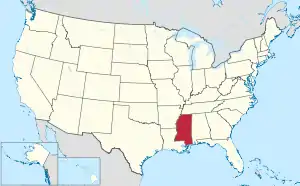Tate County, Mississippi
Tate County is a county located in the northwestern portion of the U.S. state of Mississippi. As of the 2010 census, the population was 28,886.[1] Its county seat is Senatobia.[2] Organized in 1873 during the Reconstruction era, from portions of DeSoto, Marshall, and Tunica counties, the county is named for Thomas Simpson Tate, one of the first prominent American settlers of the area.
Tate County | |
|---|---|
 Location within the U.S. state of Mississippi | |
 Mississippi's location within the U.S. | |
| Coordinates: 34°39′N 89°56′W | |
| Country | |
| State | |
| Founded | 1873 |
| Seat | Senatobia |
| Largest city | Senatobia |
| Area | |
| • Total | 411 sq mi (1,060 km2) |
| • Land | 405 sq mi (1,050 km2) |
| • Water | 6.2 sq mi (16 km2) 1.5% |
| Population (2010) | |
| • Total | 28,886 |
| • Estimate (2018) | 28,759 |
| • Density | 70/sq mi (27/km2) |
| Time zone | UTC−6 (Central) |
| • Summer (DST) | UTC−5 (CDT) |
| Congressional district | 1st |
Tate County is part of the Memphis, TN-MS-AR Metropolitan Statistical Area. It is located about 40 miles (64 km) south of Memphis and one county east of the Mississippi River. This fertile river valley was developed for cotton cultivation in the 19th century.
History
As it was developed for cotton culture in the antebellum years, planters in the county depended on the labor of enslaved African Americans. Blacks comprised a majority of the population for many decades. After Reconstruction, whites sometimes enforced their dominance through political intimidation or violence against blacks.
In 1932, a deputy sheriff and son of County Sheriff C.A. Williams, was allegedly shot by a black man, Jesse Williams. Sheriff Williams illegally organized a posse and murdered at least five and possibly as many as seven black people, family members of a man known as "Judge" Crawford. A month later Jesse Williams was caught, "tried" and lynched by hanging. No charges were ever considered against the sheriff or lynch mob.[3]
Geography

According to the U.S. Census Bureau, the county has a total area of 411 square miles (1,060 km2), of which 405 square miles (1,050 km2) is land and 6.2 square miles (16 km2) (1.5%) is water.[4] It is the third-smallest county in Mississippi by land area.
Major highways
Adjacent counties
- DeSoto County (north)
- Marshall County (east)
- Lafayette County (southeast)
- Panola County (south)
- Tunica County (west)
Demographics
| Historical population | |||
|---|---|---|---|
| Census | Pop. | %± | |
| 1880 | 18,721 | — | |
| 1890 | 19,253 | 2.8% | |
| 1900 | 20,618 | 7.1% | |
| 1910 | 19,714 | −4.4% | |
| 1920 | 19,636 | −0.4% | |
| 1930 | 17,671 | −10.0% | |
| 1940 | 19,309 | 9.3% | |
| 1950 | 18,011 | −6.7% | |
| 1960 | 18,138 | 0.7% | |
| 1970 | 18,544 | 2.2% | |
| 1980 | 20,119 | 8.5% | |
| 1990 | 21,432 | 6.5% | |
| 2000 | 25,370 | 18.4% | |
| 2010 | 28,886 | 13.9% | |
| 2018 (est.) | 28,759 | [5] | −0.4% |
| U.S. Decennial Census[6] 1790-1960[7] 1900-1990[8] 1990-2000[9] 2010-2013[1] | |||
As of the census[10] of 2000, there were 25,370 people, 8,850 households, and 6,717 families residing in the county. The population density was 63 people per square mile (24/km2). There were 9,354 housing units at an average density of 23 per square mile (9/km2). The racial makeup of the county was 67.84% White, 31.02% Black or African American, 0.20% Native American, 0.10% Asian, 0.04% Pacific Islander, 0.25% from other races, and 0.56% from two or more races. 0.88% of the population were Hispanic or Latino of any race.
There were 8,850 households, out of which 36.10% had children under the age of 18 living with them, 56.00% were married couples living together, 15.50% had a female householder with no husband present, and 24.10% were non-families. 21.30% of all households were made up of individuals, and 9.10% had someone living alone who was 65 years of age or older. The average household size was 2.74 and the average family size was 3.18.
As of 2000, the county's population was spread out, with 27.10% under the age of 18, 11.70% from 18 to 24, 27.50% from 25 to 44, 22.30% from 45 to 64, and 11.40% who were 65 years of age or older. The median age was 34 years. For every 100 females there were 93.70 males. For every 100 females age 18 and over, there were 90.50 males.
The median income for a household in the county was $35,836, and the median income for a family was $41,423. Males had a median income of $33,064 versus $21,154 for females. The per capita income for the county was $16,154. About 10.60% of families and 13.50% of the population were below the poverty line, including 14.20% of those under age 18 and 21.10% of those age 65 or over.
Politics
| Year | Republican | Democratic | Third parties |
|---|---|---|---|
| 2020 | 66.5% 8,707 | 32.0% 4,183 | 1.6% 203 |
| 2016 | 64.5% 7,495 | 33.8% 3,926 | 1.8% 206 |
| 2012 | 59.1% 7,332 | 39.8% 4,933 | 1.1% 141 |
| 2008 | 60.1% 7,678 | 39.2% 5,003 | 0.8% 97 |
| 2004 | 60.5% 6,760 | 38.9% 4,347 | 0.5% 60 |
| 2000 | 59.2% 5,148 | 39.6% 3,441 | 1.2% 104 |
| 1996 | 50.4% 3,694 | 43.6% 3,195 | 6.0% 441 |
| 1992 | 50.1% 4,196 | 42.0% 3,519 | 7.8% 656 |
| 1988 | 61.1% 4,553 | 38.6% 2,872 | 0.3% 24 |
| 1984 | 61.9% 4,677 | 37.7% 2,846 | 0.5% 34 |
| 1980 | 45.4% 3,343 | 52.8% 3,892 | 1.8% 131 |
| 1976 | 38.8% 2,497 | 58.2% 3,747 | 3.0% 192 |
| 1972 | 75.7% 3,966 | 22.0% 1,151 | 2.3% 119 |
| 1968 | 13.2% 605 | 25.4% 1,162 | 61.4% 2,810 |
| 1964 | 89.4% 2,390 | 10.6% 283 | |
| 1960 | 13.6% 241 | 38.7% 686 | 47.7% 845 |
| 1956 | 9.8% 171 | 80.9% 1,414 | 9.4% 164 |
| 1952 | 19.7% 387 | 80.3% 1,575 | |
| 1948 | 1.1% 16 | 14.1% 199 | 84.8% 1,197 |
| 1944 | 2.0% 29 | 98.1% 1,455 | |
| 1940 | 0.2% 3 | 99.8% 1,609 | |
| 1936 | 0.6% 7 | 99.4% 1,088 | |
| 1932 | 0.9% 9 | 99.0% 986 | 0.1% 1 |
| 1928 | 3.2% 42 | 96.8% 1,274 | |
| 1924 | 0.6% 6 | 98.8% 1,002 | 0.6% 6 |
| 1920 | 11.7% 117 | 87.3% 876 | 1.1% 11 |
| 1916 | 1.6% 18 | 97.7% 1,074 | 0.6% 7 |
| 1912 | 3.3% 23 | 86.8% 612 | 9.9% 70 |
Notable people
- Actor James Earl Jones was born in Arkabutla, Mississippi, an unincorporated area of Tate County and lived here for five years. He was sent north to live with his maternal grandparents on their farm in Jackson, Michigan.
See also
References
| Wikimedia Commons has media related to Tate County, Mississippi. |
- "State & County QuickFacts". United States Census Bureau. Retrieved September 7, 2013.
- "Find a County". National Association of Counties. Retrieved 2011-06-07.
- "Entire Black Family Murdered In Unsuccessful Manhunt (1932)". Archived from the original on June 4, 2019. Retrieved 16 December 2017.
- "2010 Census Gazetteer Files". United States Census Bureau. August 22, 2012. Archived from the original on September 28, 2013. Retrieved November 8, 2014.
- "Population and Housing Unit Estimates". Retrieved November 8, 2019.
- "U.S. Decennial Census". United States Census Bureau. Retrieved November 8, 2014.
- "Historical Census Browser". University of Virginia Library. Retrieved November 8, 2014.
- "Population of Counties by Decennial Census: 1900 to 1990". United States Census Bureau. Retrieved November 8, 2014.
- "Census 2000 PHC-T-4. Ranking Tables for Counties: 1990 and 2000" (PDF). United States Census Bureau. Retrieved November 8, 2014.
- "U.S. Census website". United States Census Bureau. Retrieved 2008-01-31.
- Leip, David. "Dave Leip's Atlas of U.S. Presidential Elections". uselectionatlas.org. Retrieved 2018-03-06.
External links
- Tate County Economic Development Foundation
- The Democrat - Weekly newspaper serving Tate County.
- Tate County Sheriff

.svg.png.webp)






